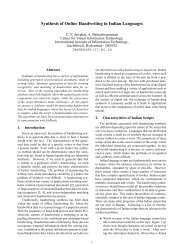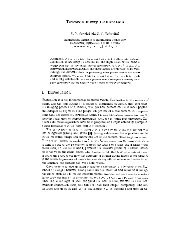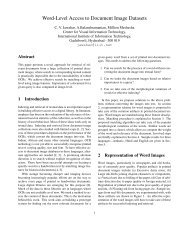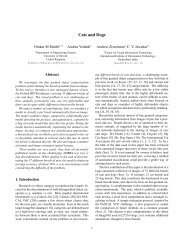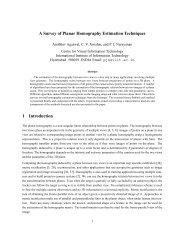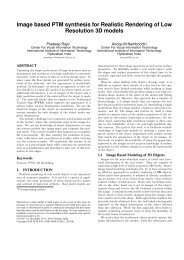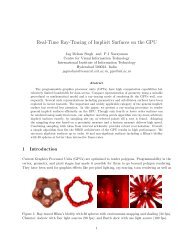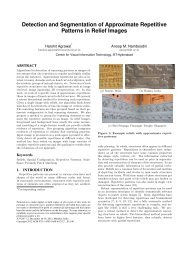New List - CVIT
New List - CVIT
New List - CVIT
- No tags were found...
You also want an ePaper? Increase the reach of your titles
YUMPU automatically turns print PDFs into web optimized ePapers that Google loves.
• Dedicated co-processorsthat handle displayoutput.• Increasinglyprogrammable andpowerful• Latest GPUs have over 1TFLOP of peakperformance• CUDA• Hardware Architecture• Programming Model• API to Program the GPU ina C-like environment
• Algorithms which have irregular memoryaccess patterns• Difficult to implement and parallelize withhigh performance on current generationarchitectures• Does not “play nice” with the memory hierarchy▪ Cache/Virtual Memory Issues• Eg: <strong>List</strong> Ranking, Tree Computations etc.
• Classic Irregular Algorithm• Find the position of every element in a linkedlist• Becomes Irregular when list elements arescattered in memory• Difficult to parallelize• Many applications in Graph Problems• Tree Computations, Biconnected Componentsetc.
• Many Algorithms for Parallelization• Pointer Jumping Technique• Randomized Approaches• Sparse Ruling Set Approaches
• Pointer Jumping Technique for the GPU• Wyllie’s Algorithm and variants for the GPU• A work-optimal, recursive algorithm for theGPU• Applications of <strong>List</strong> Ranking• Euler Tour Construction and Tree Computations onthe GPU• Performance Analysis and Behavior of suchIrregular Algorithms on the GPU
• 240 cores• 4-stage pipeline on each core• 960 threads in flight at any given time.• Memory allocated for a set of 8 Cores (SM)• 64K Registers• 16 KB Shared Memory• 8K Constant Cache• 8K Texture Cache
Thread Execution Control Unit1 2 M-1M1 23 45 67 8SpecialFunctionUnit1 23 45 67 8SpecialFunctionUnitProcessors, Control Units,Shared Memory andRegisters(on-chip area)Multi Processors1 23 45 67 8SpecialFunctionUnit1 23 45 67 8SpecialFunctionUnitSharedMemory +RegistersSharedMemory +RegistersSharedMemory +RegistersSharedMemory +RegistersDevice Memory (off-chip area)
Registers(64KB)SIMD Multi Processor #30SIMD Multi Processor #2SIMD Multi Processor #1Shared Memory (16KB)RegistersRegisters(64KB)(64KB)InstructionP 1 P 2 P 8UnitTexture Cache (8KB)Constant Cache (8KB)Device Memory (~1GB)
CPU / HostKernel 1GridBlocks(0,0)GPU / DeviceBlocks(1,0)Blocks(2,0)Kernel 2GridBlocks(0,1)Blocks(0,0)Thread(0,0)Thread(0,1)Thread(0,2)Blocks(1,1)Block (1,0)Thread(1,0)(1,1)Blocks(1,0)ThreadThread(1,2)Thread(2,0)Thread(2,1)Thread(2,2)Blocks(2,1)Thread(3,0)Blocks(2,0)Thread(3,1)Thread(3,2)Blocks(0,1)Thread(0,3)Blocks(1,1)Thread(1,3)Thread(2,3)Blocks(2,1)Thread(3,3)
• Primitives on GPU to use for larger problems• Scan by Mark Harris et. al• Reduce Operations by NVIDIA• Efficient Sorting on GPU• <strong>List</strong> Ranking is a primitive for lots of graphproblems!
• Simple Problem (Sequentially Speaking)• Difficult to Parallelize• Can be done on ordered or random lists:1 2 3 4 5 6 7 8 9 10Ordered <strong>List</strong>1 6 2 5 7 4 9 10 3 8Unordered <strong>List</strong>
• Euler Tour Technique• Load Balancing• Tree Contraction• Expression Evaluation• Planar Graph Embedding• Etc..
• A basic technique in parallel computing.• Processing Data in Rooted Directed Trees7116510491 2 38
• A basic technique in parallel computing.• Processing Data in Rooted Directed Trees7111 2659 10438
• A basic technique in parallel computing.• Processing Data in Rooted Directed Trees71112345 68 9 10
• From PRAM to the GPU• One thread per element• Successor Array Implementation7116510491 2 38
• Use pointer jumping repeatedly for eachelement of a linked list in Parallel• Update Rank and Successor simultaneously
• Implemented in CUDA• One Thread per list element• Synchronize the write operation (rank andsuccessor fields of an element should be writtento simultaneously)• Pack the two numbers into a 64-bit long integer32 bits 32 bitsrank [ i ] successor [ i ]64 bits
100001000Time (Milliseconds)1001010.10.010.0011K 2K 4K 8K 16K 32K 64K 128K 256K 512K 1M 2M 4M 8M 16M 32M 64MGTX280 0.065 0.087 0.127 0.22 0.359 0.686 1.21 2.747 6.313 12.48 26.4 56.84 130.1 279.6 615.6 1359 2841Core i7 0.006 0.01 0.018 0.047 0.105 0.535 1.357 3.051 6.395 14.8 35.09 128.3 324.3 730.1 1582 3352 6929<strong>List</strong> Size
• For lists of size < 2 16• Pack rank and successor in a 32-bit integer• Potential applications in Sparse ForestsTime (Milliseconds)0.80.70.60.50.40.30.20.101K 2K 4K 8K 16K 32K32 bit 0.054 0.069 0.104 0.166 0.234 0.41764 bit 0.065 0.087 0.127 0.22 0.359 0.686<strong>List</strong> Size
• The original algorithm has n threads workingon n elements, each thread doing O(log n)work in the PRAM model• GPU is not fully PRAM-compliant -threadexecution is asynchronous• Force synchronous behavior by jumping oncein the kernel and forcing a globalsynchronization.
• Threads would load an element and it’ssuccessor even if it’s pointing to end of list• Modify Kernel to load elements as needed.• Block-Synchronize to force eligible threads toaccess memory more efficiently
40961024256Time (Milliseconds)6416410.250.06250.0156251K 2K 4K 8K 16K 32K 64K 128K 256K 512K 1M 2M 4M 8M 16M 32M 64MOriginal 0.07 0.095 0.153 0.272 0.395 0.751 1.242 2.908 6.603 13.35 28.85 64.37 148.4 321.7 708.4 1565 3294Stepwise 0.387 0.423 0.463 0.543 0.68 0.942 1.269 2.109 4.313 9.165 20.47 46.7 102.8 221.3 462.9 1952 3094Optimized 0.052 0.058 0.059 0.083 0.125 0.237 0.419 1.123 2.86 6.535 14.49 32.83 73.01 163.3 377.6 840.2 1718<strong>List</strong> Size
• Wyllie’s Algorithm is not optimal in PRAM model• O(n log n) work for something that can be done inO(n)• Expensive synchronization on GPU (64 bitpacking and write operations)• Random Reads from Global Memory• ~400-600 GPU cycles of read latency for each element• There has to be a better way!• Is there a better algorithm?
• Designed for SMPs – Sparse Ruling Set approach• Mark a number of elements as ‘splitters’• Traverse the list from multiple points by each threadusing the splitters as a starting point• Store ranks w.r.t splitter position for each element• Stop when you hit another splitter (as marked in firststep)• Construct new, smaller list for global ranks• Rank the new list and add the list prefixes to eachelement of the list
SuccessorArray2 4 8 1 9 3 7 - 5 6Step 1. Select Splitters at equal intervals
SuccessorArrayLocal Ranks2 4 8 1 9 3 7 - 5 60 0 0 0 0 0 0 0 0 0Step 2. Traverse the <strong>List</strong> until the next splitter is metand increment local ranks as we progress
SuccessorArrayLocal Ranks2 4 8 1 9 3 7 - 5 60 0 1 0 1 1 0 0 0 1Step 2. Traverse the <strong>List</strong> until the next splitter is metand increment local ranks as we progress
SuccessorArrayLocal Ranks2 4 8 1 9 3 7 - 5 60 0 1 2 0 1 2 0 0 1Step 2. Traverse the <strong>List</strong> until the next splitter is metand increment local ranks as we progress
SuccessorArrayLocal Ranks2 4 8 1 9 3 7 - 5 60 3 1 2 0 1 2 3 0 1Step 3. Stop When all elements have been assigned a local rank
SuccessorArrayLocal Ranks2 4 8 1 9 3 7 - 5 60 3 1 2 0 1 2 3 0 1Step 4. Create a new list of splitters which contains a prefix value that is equalto the local rank of it’s predecessor
SuccessorArrayLocal Ranks2 4 8 1 9 3 7 - 5 60 3 1 2 0 1 2 3 0 1Step 4. Create a new list of splitters which contains a prefix value that is equalto the local rank of it’s predecessor<strong>New</strong> <strong>List</strong>Successor ArrayGlobal Ranks2 - 10 4 2
SuccessorArrayLocal Ranks2 4 8 1 9 3 7 - 5 60 3 1 2 0 1 2 3 0 1Step 5. Scan the global ranks array sequentially<strong>New</strong> <strong>List</strong>Successor ArrayGlobal Ranks2 - 10 4 22 - 10 6 2 After Ranking
SuccessorArrayLocal Ranks2 4 8 1 9 3 7 - 5 60 3 1 2 0 1 2 3 0 1Step 6. Add the global ranks to the corresponding local ranks to get the finalrank of the list.<strong>New</strong> <strong>List</strong>Successor ArrayGlobal Ranks2 - 10 4 22 - 10 6 2 After RankingLocal RanksFinal Ranks0 3 1 2 0 1 2 3 0 10 0 0 0 0 0 0 0 0 0
SuccessorArrayLocal Ranks2 4 8 1 9 3 7 - 5 60 3 1 2 0 1 2 3 0 1Step 6. Add the global ranks to the corresponding local ranks to get the finalrank of the list.<strong>New</strong> <strong>List</strong>Successor ArrayGlobal Ranks2 - 10 4 22 - 10 6 2 After RankingLocal RanksFinal Ranks0 3 1 2 0 1 2 3 0 10 5 1 0 0 0 2 0 0 0
SuccessorArrayLocal Ranks2 4 8 1 9 3 7 - 5 60 3 1 2 0 1 2 3 0 1Step 6. Add the global ranks to the corresponding local ranks to get the finalrank of the list.<strong>New</strong> <strong>List</strong>Successor ArrayGlobal Ranks2 - 10 4 22 - 10 6 2 After RankingLocal RanksFinal Ranks0 3 1 2 0 1 2 3 0 10 5 1 4 0 0 2 0 0 0
SuccessorArrayLocal Ranks2 4 8 1 9 3 7 - 5 60 3 1 2 0 1 2 3 0 1Step 6. Add the global ranks to the corresponding local ranks to get the finalrank of the list.<strong>New</strong> <strong>List</strong>Successor ArrayGlobal Ranks2 - 10 4 22 - 10 6 2 After RankingLocal RanksFinal Ranks0 3 1 2 0 1 2 3 0 10 5 1 4 0 3 2 0 0 0
SuccessorArrayLocal Ranks2 4 8 1 9 3 7 - 5 60 3 1 2 0 1 2 3 0 1Step 6. Add the global ranks to the corresponding local ranks to get the finalrank of the list.<strong>New</strong> <strong>List</strong>Successor ArrayGlobal Ranks2 - 10 4 22 - 10 6 2 After RankingLocal RanksFinal Ranks0 3 1 2 0 1 2 3 0 10 5 1 4 0 3 2 0 1 0
SuccessorArrayLocal Ranks2 4 8 1 9 3 7 - 5 60 3 1 2 0 1 2 3 0 1Step 6. Add the global ranks to the corresponding local ranks to get the finalrank of the list.<strong>New</strong> <strong>List</strong>Successor ArrayGlobal Ranks2 - 10 4 22 - 10 6 2 After RankingLocal RanksFinal Ranks0 3 1 2 0 1 2 3 0 10 5 1 4 6 3 2 0 1 0
SuccessorArrayLocal Ranks2 4 8 1 9 3 7 - 5 60 3 1 2 0 1 2 3 0 1Step 6. Add the global ranks to the corresponding local ranks to get the finalrank of the list.<strong>New</strong> <strong>List</strong>Successor ArrayGlobal Ranks2 - 10 4 22 - 10 6 2 After RankingLocal RanksFinal Ranks0 3 1 2 0 1 2 3 0 10 5 1 4 6 3 2 9 1 0
SuccessorArrayLocal Ranks2 4 8 1 9 3 7 - 5 60 3 1 2 0 1 2 3 0 1Step 6. Add the global ranks to the corresponding local ranks to get the finalrank of the list.<strong>New</strong> <strong>List</strong>Successor ArrayGlobal Ranks2 - 10 4 22 - 10 6 2 After RankingLocal RanksFinal Ranks0 3 1 2 0 1 2 3 0 10 5 1 4 6 3 2 9 1 7
SuccessorArrayLocal Ranks2 4 8 1 9 3 7 - 5 60 3 1 2 0 1 2 3 0 1Step 6. Add the global ranks to the corresponding local ranks to get the finalrank of the list.<strong>New</strong> <strong>List</strong>Successor ArrayGlobal Ranks2 - 10 4 22 - 10 6 2 After RankingLocal RanksFinal Ranks0 3 1 2 0 1 2 3 0 10 5 1 4 6 3 2 9 1 7
• Assume you select n/log n splitters (for largenumber of threads)• The resulting list itself will be very large• Will slow down the computation as that hasto be computed sequentially• Amdahl’s Law comes into effect• Large portion of the time is spent in serial sectionof the Code
• Recursively apply the algorithm in parallel onthe newly generated list• Stop at a list that’s small enough to process veryquickly by one thread• We continue to extract parallelism until theresultant list becomes small
SuccessorArrayLocal Ranks2 4 8 1 9 3 7 - 5 60 3 1 2 0 1 2 3 0 1Make step 5 recursive to allow the GPU to continue processing thelist in parallel<strong>New</strong> <strong>List</strong>Successor ArrayGlobal Ranks2 - 10 4 22 - 10 6 2 After Ranking
SuccessorArrayLocal Ranks2 4 8 1 9 3 7 - 5 60 3 1 2 0 1 2 3 0 1Make step 5 recursive to allow the GPU to continue processing thelist in parallel<strong>New</strong> <strong>List</strong>Successor ArrayGlobal Ranks2 - 10 4 22 - 10 6 2 After RankingProcess this list again using thealgorithm and reduce it further.
• Each phase is coded as separate GPU kernel• Since each step requires global synchronization.▪ Splitter Selection▪ Each thread chooses a splitter▪ Local Ranking▪ Each thread traverses its corresponding sublist and get the globalranks▪ Recursive Step▪ Recombination Step▪ Each thread adds the global and local ranks for each element
• Convergence can be met until list size is 1• We also have the option to send a small list toCPU or Wyllie’s algorithm so that it can beprocessed faster than on this algorithm.• May save about 1% time
• Notice that choosing splitters in a random listyields uneven sublists• We can attempt to load balance thealgorithm by varying the no. of splitters wechoose.• n/log n works for small lists, n/2 log 2 n workswell for lists > 8 M.
1024256Time (Milliseconds)6416410.250.06250.0156251K 2K 4K 8K 16K 32K 64K 128K 256K 512K 1M 2M 4M 8M 16M 32M 64MWyllie (RO) 0.052 0.058 0.059 0.083 0.125 0.237 0.419 1.123 2.86 6.535 14.49 32.83 73.01 163.3 377.6 840.2 1718RHJ (log n) 0.297 0.27 0.351 0.378 0.501 0.538 0.692 0.926 1.576 3.001 6.188 13.04 27.64 57.52 117.8 239.7 488.9RHJ (2log2n) 0.259 0.493 0.501 1.089 0.954 1.444 2.369 2.914 3.731 4.992 8.557 16.32 30.09 49.75 99.08 200.7 388.2<strong>List</strong> Size
• Two factors that contribute to performance• Random lists• Load Balancing among threads• Test the effects on four configurations• Ordered <strong>List</strong>• Ordered Unbalanced <strong>List</strong>• Random Balanced <strong>List</strong>• Random
140120100Time (Milliseconds)8060402001M 2M 4M 8M 16MOrdered <strong>List</strong> 2.719 4.956 9.56 18.615 36.432Ordered/Unbalanced 5.897 12.111 24.523 49.585 99.716Random/Balanced 5.649 12.211 26.164 54.992 112.59Random <strong>List</strong> 6.188 13.038 27.638 57.516 117.771<strong>List</strong> Size
• Ordered <strong>List</strong>s are <strong>List</strong>s with successor ofelement i = i+1• <strong>List</strong> Ranking on Ordered <strong>List</strong> is equivalent toscanTime (Milliseconds)1000.00100.0010.001.000.10512K 1M 2M 4M 8M 16MCPU 3.55 7.12 14.27 28.55 56.62 113.96GPU RHJ 1.61 2.72 4.96 9.56 18.62 36.43CUDPP 0.32 0.59 1.13 2.21 4.37 8.68<strong>List</strong> Size
Time (Milliseconds)4003503002502001501005001M 2M 4M 8MCell BE 32.49 44.96 106.41 374.44GTX280 6.188 13.038 27.638 49.749<strong>List</strong> SizeRunning Time (Milliseonds)1400120010008006004002000GTX280 MTA-8 Cell BE Q6600 E4500Milliseconds 49 69.66 374.1 1088.76 1155.84Fastest single-chip <strong>List</strong> Ranking implementation (at time of publishing)
• Parallel Processing of Graphs• Utilizes <strong>List</strong> Ranking• Can be used for a variety of TreeComputations• Parent Finding• Traversal• Vertex Levels• Subtree Size
• Use two linked lists:• Adjacency <strong>List</strong> (Contains pointers from eachvertex to the set of edges it’s adjacent to)• Edge <strong>List</strong> (<strong>List</strong> of edges in the tree)
Each edge is replaced with a set of anti-parallel arcs, and anadditional pointer for each edge pointing to their anti-parallelsibling
• Once the Eulerian graph of Tree T is created,an Euler path can be created• Number the edges in some order and create alinked list4 5 3 2 6 31 2 3 4 5 6• Can be done for all edges in parallel:EP[e]=(EL[e].sib).next
• Once an Euler Path is constructed, it is rankedusing the <strong>List</strong> Ranking algorithm• Tree Computations• Parent Finding▪ Mark incoming and outgoing edges according to ranks▪ If R[xy]
• Preorder Traversal▪ Assign 1 to forward edge, 0 to reverse edge▪ Scan Weights, preorder numbering is obtained• Vertex Levels▪ Assign 1 to forward edge, -1 to reverse edge▪ Scan weights, level of each vertex is obtained.
Load TreeConstruct Euler Path EPPerform <strong>List</strong> Rank on EPFind Parent of each NodeRooted TreeSubtree Size Calculation Assign Weights (1,-1) Assign Weights (0,1)CUDPP ScanCUDPP ScanVertex LevelTraversal
Tree Rooting and Sublist Size Calculation (Random Binary Trees)1024.00Time (Milliseconds)256.0064.0016.004.001.001M 2M 4M 8M 16MGPU ETT 7.50 14.71 28.11 56.70 111.28GPU BFS 17.29 32.14 63.94 125.90 253.42CPU BFS 66.59 142.29 319.59 578.73 1174.66No. of Vertices
120.00160.00100.00140.00Time (Milliseconds)80.0060.0040.00Time (Milliseconds)120.00100.0080.0060.0040.0020.0020.000.001M 2M 4M 8M 16MFindParent 0.77 1.49 2.93 5.88 11.70<strong>List</strong> Ranking 5.21 10.26 19.28 39.17 76.35EP Construction 1.52 2.96 5.90 11.65 23.23No. of VerticesParent Finding0.001M 2M 4M 8M 16MLast Kernel 0.66 1.30 2.60 5.17 10.36CUDPP Scan 0.55 0.98 1.72 3.31 6.50FindParent 1.12 2.16 4.24 8.40 16.90<strong>List</strong> Ranking 5.21 10.26 19.28 39.17 76.35EP Construction 1.52 2.96 5.90 11.65 23.23No. of VerticesPreorder Traversal
• A Performance prediction model that lets youestimate the runtime of a GPU program• Inputs from PRAM, BSP, QRQW models• Developed by Kothapalli et. al.• Based on Cycle Estimationcyclesseconds
• Kernel Cycles consists of• Data Instructions• Compute Instructions▪ Simple to compute• Difficult to estimate time taken for a datainstruction to be serviced• Global memory can take around 300 cyclescompared to 4 cycles for compute• Performance is Memory bound
• Global Memory can fetch up to 128 bytes in asingle transaction• If all threads of a half-warp access elements in 128byte segment at the same time – then bandwidthimproves• Unlikely to happen with irregular memoryapplications• What’s the effect of un-coalesced memoryaccesses?
Memory Transactions128-byte segmentsThreadsThread 1Thread 2Thread 3Segment 1 Segment 2 Segment 3GLOBAL MEMORYThread 14Thread 15Thread 16Segment n-2 Segment n-1 Segment nMemory Transactions
• Estimate how much coalescing is happening• “Instantaneous Degree of Locality”• Estimate cycles per warp• Regard all memory transactions are uncoalescedfor irregular applications.• Memory instructions will overshadow compute innumber of cycles
• Calculations
90.00080.000Expected RuntimeActual Runtime70.000Time (Milliseonds)60.00050.00040.00030.00020.00010.0000.000256K 512K 1M 2M 4M 8M 16M<strong>List</strong> Size
• Exploiting massive parallelism of the GPU• Enough threads to offset memory access latencies• Small input data which fits on CPU cache will befaster on CPU• Avoid over-reliance on expensivesynchronization• Load Balancing through probabilistic meansof dividing work
• Pointer Jumping for GPUs• Implemented with some optimization techniquesfor problems that require it.• <strong>List</strong> Ranking for GPUs• Our implementation was the fastest single-chipimplementation at time of publishing• Applied LR for Tree Computations with goodresults• Strategies for Irregular Algorithms on theGPU
• 2007 – 2008 Course Work at IIIT-H• Parallel Algorithms, Parallel Programming, MulticoreArchitectures, Graph Theory• August 2008 – Work on <strong>List</strong> Ranking Started• Jan 2009 – Work accepted at ICS 2009• August 2009 – Started work on Tree Computations• Current Work – Book Chapter in GPU ComputingGems, Tree Computations on GPU and LargerApplications• April 2010: Wei and JaJa’s paper at IPDPS 2010improves upon our work, 30% faster timingsoptimizing thread count and load balancing withappropriate splitter selection.




